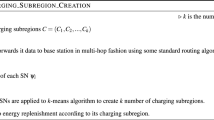Abstract
Wireless energy charging using mobile vehicles has been a viable research topic recently in the area of wireless networks and mobile computing. This paper gives a short survey of recent research conducted in our research group in the area of collaborative mobile charging. In collaborative mobile charging, multiple mobile chargers work together to accomplish a given set of objectives. These objectives include charging sensors at different frequencies with a minimum number of mobile chargers and reaching the farthest sensor for a given set of mobile chargers, subject to various constraints, including speed and energy limits of mobile chargers. Through the process of problem formulation, solution construction, and future work extension for problems related to collaborative mobile charging and coverage, we present three principles for good practice in conducting research. These principles can potentially be used for assisting graduate students in selecting a research problem for a term project, which can eventually be expanded to a thesis/dissertation topic.
Similar content being viewed by others
References
Atzori L, Iera A, Morabito G. The Internet of Things: A survey. Computer Networks: Int. J. Computer and Telecommunications Networking, 2010, 54(15): 2787-2805.
Shah R C, Roy S, Jain S, Brunette W. Data MULEs: Modeling a three-tier architecture for sparse sensor networks. In Proc. the 1st IEEE SNPA Workshop, May 2003, pp.30-41.
Zhao W, Ammar M, Zegura E. A message ferrying approach for data delivery in sparse mobile ad hoc networks. In Proc. the 5th ACM MobiHoc, May 2014, pp.187-198.
Bentham J. An Introduction to the Principles of Morals and Legislation. Clarendon Press, 1879.
Hardy G H. A Mathematician’s Apology. Cambridge University Press, 1992.
Dijkstra E W. Self-stabilizing systems in spite of distributed control. Commun. ACM, 1974, 17(11): 643-644.
Beigel R, Wu J, Zheng H. On optimal scheduling of multiple mobile chargers in wireless sensor networks. In Proc. the 1st International Workshop on Mobile Sensing, Computing and Communication. (to be appeared)
Zhang S, Wu J, Lu S. Collaborative mobile charging for sensor networks. In Proc. the 9th IEEE MASS, Oct. 2012, pp.84-92.
Current J R, Schilling D A. The covering salesman problem. Transportation Science, 1989, 23(3): 208-213.
Srinivasan A, Wu J. TRACK: A novel connected dominating set based sink mobility model for WSNs. In Proc. the 17th IEEE ICCCN, Aug. 2008, pp.1-8.
Li K, Luan H, Shen C C. Qi-ferry: Energy-constrained wireless charging in wireless sensor networks. In Proc. IEEE WCNC, April 2012, pp.2515-2520.
Gandham S, Dawande M, Prakash R et al. Energy efficient schemes for wireless sensor networks with multiple mobile base stations. In Proc. IEEE GLOBECOM, Dec. 2003, pp.377-381.
Wu J, Yang S, Dai F. Logarithmic store-carry-forward routing in mobile ad hoc networks. IEEE Transactions on Parallel and Distributed Systems, 2007, 18(6): 735-748.
He S, Chen J, Jiang F, Yau D K, Xing G, Sun Y. Energy provisioning in wireless rechargeable sensor networks. In Proc. IEEE INFOCOM, April 2011, pp.2006-2014.
Kurs A, Karalis A, Moffatt R, Joannopoulos J D, Fisher P, Soljačić M. Wireless power transfer via strongly coupled magnetic resonances. Science, 2007, 317 (5834): 83-86.
Ahn D, Hong S. Effect of coupling between multiple transmitters or multiple receivers on wireless power transfer. IEEE Trans. Industrial Electronics, 2013, 60(7): 2602-2613.
Liu V, Parks A, Talla V et al. Ambient backscatter: Wireless communication out of thin air. SIGCOMM Comput. Commun. Rev., 2013, 43(4): 39-50.
Xie L, Shi Y, Hou Y T, Lou W, Sherali H D, Midkiff S F. Bundling mobile base station and wireless energy transfer modeling and optimization. In Proc. IEEE INFOCOM, April 2013, pp.1636-1644.
Guo S, Wang C, Yang Y. Mobile data gathering with wireless energy replenishment in rechargeable sensor networks. In Proc. IEEE INFOCOM, April 2013, pp.1932-1940.
Author information
Authors and Affiliations
Corresponding author
Additional information
The work was supported in part by the National Science Foundation of USA under Grant Nos. CCF 1301774, ECCS 1231461, CNS 1156574, CNS 1065444, and ECCS 1128209.
Electronic supplementary material
Below is the link to the electronic supplementary material.
ESM 1
(PDF 136 kb)
Rights and permissions
About this article
Cite this article
Wu, J. Collaborative Mobile Charging and Coverage. J. Comput. Sci. Technol. 29, 550–561 (2014). https://doi.org/10.1007/s11390-014-1449-2
Received:
Revised:
Published:
Issue Date:
DOI: https://doi.org/10.1007/s11390-014-1449-2




